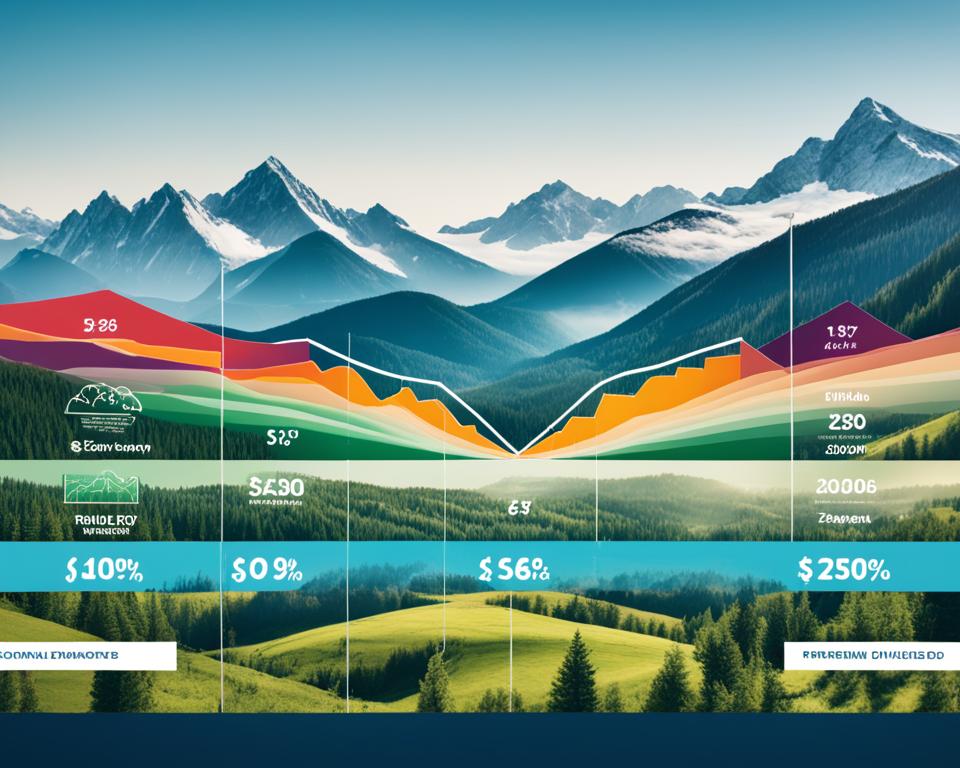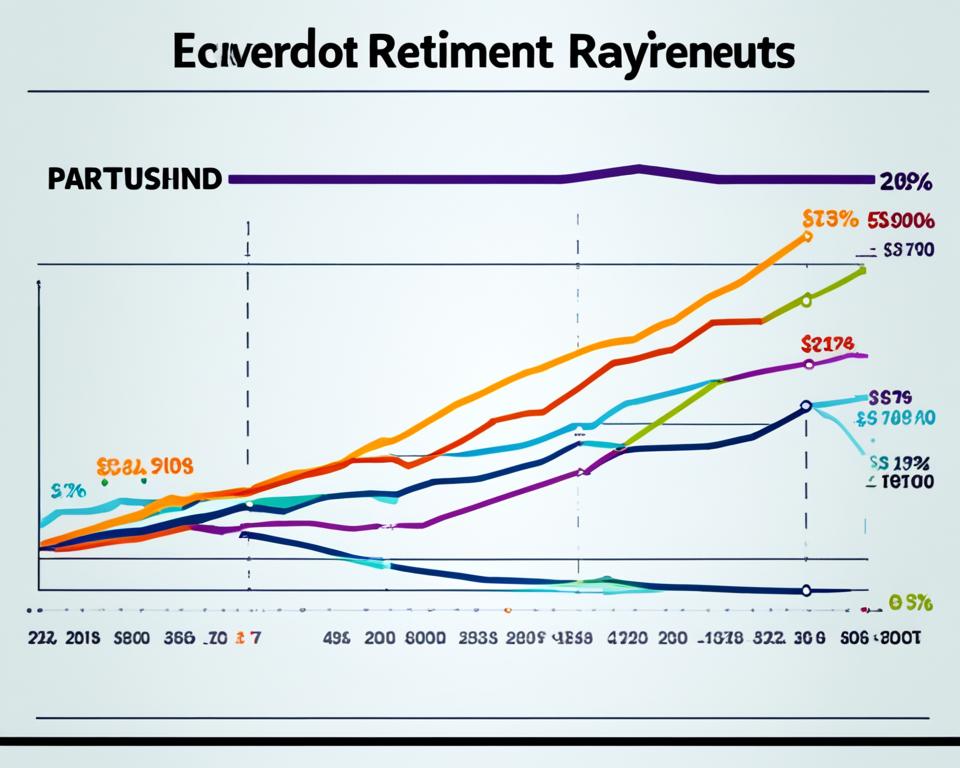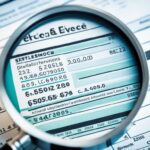As you approach the golden years of retirement, it’s crucial to ensure that your investment strategy is designed to support a comfortable and sustainable lifestyle. Creating a dividend retirement portfolio is a forward-thinking approach that provides you with a steady stream of income, complementing other retirement savings and Social Security benefits. This method centers not just on the present, but also on securing your financial future, as dividends can offer both immediate cash flow and potential for long-term growth.
By retirement investment planning with dividends, you’re choosing a path that allows you to reap the benefits of a company’s earnings regularly. And when done right, this approach offers tax-efficient returns that enhance your fiscal positioning in later life. But the question stands—how do you go about creating a sustainable retirement portfolio that leverages dividends to the fullest? The key lies in informed asset selection, timing, and managerial strategies—all of which can become more effective with professional counsel.
Key Takeaways
- Determine a strategic mix of dividend-giving assets that aligns with your retirement goals.
- Understand the benefits of dividends for regular retirement income and growth potential.
- Prioritize tax efficiency by familiarizing yourself with qualified versus non-qualified dividends.
- Seek professional financial advice to tailor your portfolio to personal circumstances and market conditions.
- Stay informed on the fiscal health and dividend distribution patterns of the companies in which you invest.
Understanding Dividends and Their Role in Retirement
As you pave the path to retirement, one key strategy to consider is investing in dividend stocks for retirement. Dividends play a pivotal role in building passive income in retirement, offering a dual benefit of regular income and potential asset appreciation. For individuals focusing on retirement savings with dividends, understanding the nuances of dividend distributions is essential to maximizing the efficacy of this investment approach.
The Basics of Dividend Distributions and Their Appeals
At their core, dividends are payments made by a company to its shareholders out of its profits or reserves. When you own dividend-paying stocks, you receive a portion of the company’s earnings regularly. These payments are usually made in cash, but sometimes they can be in the form of additional shares. Such income is especially appealing to retirees as it can create a consistent flow of cash, which is particularly beneficial for those looking to enjoy their retirement without financial stress.
Qualified vs Non-Qualified Dividends: Tax Implications
It’s crucial to differentiate between qualified and non-qualified dividends due to their different tax treatments. Qualified dividends are taxed at the lower capital gains tax rates, provided they meet certain criteria regarding the holding period of the investment. Conversely, non-qualified dividends are taxed at your ordinary income tax rate, which can be higher. Accordingly, savvy investors often aim to hold onto their dividend-paying investments long enough to benefit from the reduced tax rate on qualified dividends.
Assessing Dividend Yield and Its Significance in Portfolio Management
The dividend yield, a critical measure for comparing the attractiveness of different dividend-paying assets, is obtained by dividing the annual dividends by the stock’s current price. While a high yield is often sought after, it is essential to delve deeper, as it could signify a stock price decline, raising concerns about the company’s stability—and possibly presaging dividend reductions. Wise investment decisions involve considering the sustainability of dividend yields within the larger context of market conditions and overall company health.
A table displaying the dividend yield and other relevant metrics could be particularly insightful for investors trying to make informed decisions:
| Company | Annual Dividend | Stock Price | Dividend Yield | Dividend Payout Ratio | 5-Year Yield Average |
|---|---|---|---|---|---|
| Company A | $4.00 | $100 | 4% | 60% | 3.5% |
| Company B | $2.50 | $50 | 5% | 75% | 4.2% |
| Company C | $1.00 | $40 | 2.5% | 50% | 2.3% |
By aligning your investment strategy with a deep understanding of dividends, you set the stage for a more secure and prosperous retirement. Grasping the implications of dividend types and yields not only cultivates your financial acumen but also empowers you to harness the full potential of dividend stocks for retirement.
The Pillars of Crafting a Dividend Retirement Portfolio
Embarking on the journey of dividend investing for retirees entails a nuanced understanding of how to structure a retirement income strategy that endures. The beauty of a dividend retirement portfolio lies in its ability to provide continual financial support, contributing to the overall goal of retirement portfolio diversification. Let’s delve into the foundational elements that make up a solid dividend retirement portfolio.
Selecting the Right Mix of Dividend-Generating Assets
Your investment canvas is vast when it comes to painting your future with a palette of dividend-generating assets. A mix of individual stocks, mutual funds, and Exchange-Traded Funds (ETFs) provides a balance of choice and management. Individual stocks grant you the freedom to cherry-pick companies with promising prospects and favourable tax implications. However, mutual funds and ETFs serve as an expansive tapestry, offering retirement portfolio diversification and professional management.
As important as it is to diversify, the quality of dividends—they remain consistent or increase over time—holds equal significance. It’s not solely about the number of assets but their ability to combat inflation and to grow, ensuring your investments continue to provide for you, just as you have for them.
Timing Purchases for Tax Efficiency
Investing is not just about what you buy but also when you buy it. Timing is a critical component, especially for those looking to benefit from the tax efficiency that qualified dividends bring. By strategizing your purchases, particularly in taxable accounts, you position yourself to capture the favorable tax treatment afforded by qualified dividends.
The aim here is two-fold: To select dividend-paying assets that stand the test of time and safeguard oneself against the erosive forces of taxation. Blend timing with tactical asset selection, and you’ll have forged a retirement income strategy that stands on pillars of fortitude and foresight.
Corporate Stability and Dividend Consistency
As part of your retirement investment planning, it is crucial to focus on companies known for their corporate stability and regular, consistent dividend payments. Including such stalwarts in your dividend retirement portfolio is a strategic move toward a stable and reliable income stream in retirement.
Corporate stability often translates into the ability to pay and, importantly, to regularly increase dividends. Consistently growing dividends can signal a company’s robust financial health and its potential to withstand market fluctuations—a comforting factor for retirees relying on these payments.
Consider the following table, which showcases real-life examples of companies renowned for their consistent dividend payouts and financial stability. Each company listed has demonstrated a commitment to shareholder returns, which is integral when mapping out your dividend retirement portfolio:
| Company | Sector | Years of Consecutive Dividend Growth | Current Dividend Yield | 5-Year Dividend Growth Rate |
|---|---|---|---|---|
| Johnson & Johnson | Healthcare | 58 | 2.45% | 6.5% |
| Procter & Gamble | Consumer Goods | 64 | 2.25% | 4.0% |
| Coca-Cola | Beverages | 59 | 3.10% | 3.3% |
| 3M | Industrial | 62 | 3.55% | 5.9% |
| Wal-Mart Stores | Retail | 47 | 1.55% | 1.8% |
Retirement investment planning is about looking for investments that promise longevity and growth. By anchoring your portfolio with companies holding a historical reputation for stability and consistent dividend payouts, you create a foundation that stands resilient against economic tides, ensuring your golden years are truly golden.
Retirement Portfolio Diversification: Sector and Asset Allocation
As you work towards a secure financial future, incorporating retirement portfolio diversification is a strategic step that should not be overlooked. A well-rounded dividend retirement portfolio combines investments across various sectors and asset types, effectively reducing risk while enhancing the potential for stable returns. Achieving this diversity involves balancing high-yield opportunities with assets geared toward growth, ultimately leading to a more resilient retirement income.
Asset allocation should reflect not only your risk tolerance but also your retirement timeline. Including sectors such as utilities, telecommunications, and consumer staples can provide higher dividend yields traditionally, which contribute to consistent income during retirement. These sectors tend not to be severely impacted by market volatility due to their essential nature and consistent demand, making them a staple for income-focused investors.
In contrast to these high-yielding sectors, technology and small company stocks often focus more on reinvestment and growth. While they may offer lower, or at times, no dividends, they hold the potential for significant asset appreciation. A judicious blend of both growth-oriented and income-producing assets is essential for a dividend retirement portfolio that is built to weather the fluctuations of the market while striving for continued growth.
Analyze the following table, which delineates the typical dividend yields and sector characteristics that inform a diversified retirement portfolio:
| Sector | Typical Dividend Yield | Growth Potential | Role in Diversification | Notes |
|---|---|---|---|---|
| Utilities | High | Low | Income Stability | Essential services offer resistance to economic downturns |
| Telecommunications | High | Moderate | Income with Some Growth | Ever-growing demand for connectivity services |
| Consumer Staples | High | Low | Income Stability | Regular demand for everyday goods ensures steady income |
| Technology | Low to None | High | Growth Strategy | Innovation-driven appreciation potential |
| Small Cap Stocks | Low to None | High | Growth Strategy | Smaller companies with room for significant expansion |
Your retirement portfolio diversification strategy should maintain a fluidity that allows for adjustments as market conditions evolve. By understanding the yield and growth characteristics of various sectors and adjusting your portfolio accordingly, you are laying the groundwork for a stable and prosperous retirement.
Dividend Investing for Retirees: Defensive Sector Strategies
When creating a sustainable retirement portfolio, retirees need to consider investing in defensive sectors that are known for their resilient and stable dividend yields. These sectors, which include utilities, telecommunications, and consumer staples, can serve as the cornerstone of a robust retirement income strategy that seeks to minimize exposure to volatile market conditions. Such a disciplined approach not only ensures a steady flow of dividend income but also contributes significantly to the longevity of your retirement funds.
Utilities, Telecommunications and Consumer Staples
These industries are often referred to as ‘defensive’ because they provide essential services that remain in constant demand, irrespective of economic swings. A dividend retirement portfolio that allocates investments into these sectors is likely to experience less fluctuation during market downturns. Companies in these spheres often have a long-standing history of paying out dividends, making them attractive to those who seek predictability in their retirement income strategy.
Avoiding the Pitfalls of High Dividend Yield Gambles
While high dividend yields might look appealing at first glance, they can often signal underlying issues within a company. A yield that is significantly above the industry average may indicate financial distress, which could lead to dividend cuts or the suspension of payouts altogether. Investing for retirement should focus on creating a sustainable retirement portfolio, which involves careful scrutiny of dividend yields and the financial stability of the companies offering them. Instead of chasing high yields, it’s more prudent for retirees to seek out dividends that are well-supported by fundamentals and a track record of steady payouts.
In short, your retirement income strategy should balance the lure of immediate, high dividend yields with the long-term viability and consistency of your income sources. Shielding your investments with sector diversity and informed selections will help cultivate a fruitful and lasting retirement experience.
Countering Inflation: Building a Portfolio That Outlasts Cost Increases
When you’re focused on retirement savings with dividends, safeguarding your purchasing power from inflation is a top priority. Investing in companies that not only yield dividends but commit to incrementally increasing them plays a pivotal role in dividend investing for retirees. These forward-looking investments are designed to help your savings outpace the creeping cost increases, ensuring your standard of living remains unshaken in retirement.
Inflation, as a persistent force, gnaws away at your hard-earned retirement savings, making it essential to strategically select dividend-yielding assets that are also known for their growth. Ideally, the growth rate of the dividends you receive should surpass the rate of inflation, contributing to an upswing in your retirement income’s buying power over time.
To align your portfolio for such resilience, here’s an illustrative table that examines an assortment of dividend-paying companies, spotlighting their capacity to raise dividends consistently. This data can help you, as an investor, to evaluate which entities could best serve as bulwarks against the erosion of inflation:
| Company | Sector | Dividend Yield | Annual Dividend Growth | 5-Year Inflation Rate | Dividend Growth vs Inflation |
|---|---|---|---|---|---|
| Utility Co. | Utilities | 3.5% | 5% | 2% | Positive |
| Telecom Co. | Telecommunications | 4.8% | 3% | 2% | Positive |
| Consumer Corp. | Consumer Staples | 2.9% | 6% | 2% | Positive |
As depicted, companies that extend dividends, with a continuous track record of outstripping inflation, deserve a closer look. This comparison elucidates the dynamic where not only does the current dividend yield matter, but so does the long-term trajectory of dividend expansion relative to inflation.
To build a retirement portfolio that endures, considering both current yields and historical dividend growth trends is fundamental. Dividend investing for retirees requires an eye toward the future, ensuring you’re investing in companies that take proactive steps to increase shareholder value and can weather the inflation storm, year after year.
Keeping in mind that inflation rates may vary and the past is not always a perfect predictor of the future, use the insight from this comparison as a starting point. From this benchmark, it will be crucial to continue to monitor economic trends, corporate performance, and sector stability as part of your ongoing retirement investment strategy.
Retirement Income Strategy: Synthesizing Dividends with Other Retirement Sources
As part of your retirement investment planning, it’s essential to create a harmonious balance between dividends and other sources of retirement income. By integrating dividends with the stability of Social Security, pensions, and other investments, you pave the way for a diversified and robust income stream. This blend not only supports financial flexibility but also contributes to building passive income in retirement.
Incorporating Social Security, Pensions, and Other Investments
When considering your overall retirement income strategy, it’s vital to position dividends as a complement to the predictability of Social Security and the reliability of pensions. For many retirees, Social Security benefits form the backbone of their income, so ensuring that your dividend portfolio aligns with these benefits can lead to more consistent financial coverage throughout your retirement years. Pensions, although less common than in the past, can also offer a bedrock of income that synergizes well with the variable yet potentially lucrative nature of dividends.
Utilizing Investment Calculators for Projecting Retirement Savings Sustainability
Investment calculators serve as an invaluable tool for forecasting the growth and sustainability of your dividend portfolio. By inputting various data such as the amount invested, expected dividend yields, and anticipated retirement duration, you can gain insight into how your retirement savings might perform over time. This can help alert you to potential shortfalls well before they occur, giving you the chance to adjust your retirement investment planning accordingly.
A strategic example of an investment calculator output might look something like this:
| Initial Investment | Expected Annual Dividend Yield | Years Until Retirement | Projected Annual Dividend Income |
|---|---|---|---|
| $100,000 | 4% | 20 | $4,000 |
| $200,000 | 3% | 15 | $6,000 |
| $300,000 | 2% | 10 | $6,000 |
This hypothetical table provides you with an estimate of the passive income you might expect from dividends during retirement. It also prompts consideration of how your current savings plan may need to be refined to meet your future income needs.
Your journey towards retirement requires foresight and an adaptable income strategy. By combining dividends with other reliable income sources and making use of analytical tools, you can attain the retirement lifestyle you envision. Continuously revisiting and reassessing your strategy is key to building sustainable and scalable retirement income.
Seeking Professional Guidance: When to Consult a Financial Advisor
When embarking on retirement investment planning, you may find yourself facing a labyrinth of decisions—ranging from scrutinizing tax implications to considering the right mix for retirement portfolio diversification. The complexities of creating a sustainable retirement portfolio often require expertise that extends beyond the reach of even the most diligent investors. In moments like these, seeking the guidance of a financial advisor can be an invaluable step towards ensuring that your fiscal future is as bright as it should be.
A financial advisor can navigate you through the intricate paths of portfolio management, helping to tailor a dividend retirement portfolio that’s synchronized with your long-term financial goals, risk preferences, and unique tax considerations. The insight provided by such professionals can be particularly crucial in managing and maximizing the benefits of a diverse array of assets.
- An advisor can assist in identifying dividend yielding investments predicted to outperform in terms of stability and growth.
- They can offer nuanced advice on asset allocation, ensuring that your investments are spread across various sectors to mitigate risk.
- Access to their expertise can also illuminate the prospective tax consequences of your investment activities, guiding you towards more tax-efficient strategies.
Let’s consider for a moment a scenario where you’re pondering the switch from a high-yield yet volatile utility stock to a more stable consumer goods stock with moderate growth prospects. An advisor’s role would extend beyond simple recommendations. They would examine your entire financial landscape, factoring in elements like upcoming retirement plans, current income needs, and the potential impact of such a change on your overall investment profile.
| Investment Option | Yield | Volatility | Tax Efficiency | Advisor’s Assessment |
|---|---|---|---|---|
| High-Yield Utility Stock | High | High | Varies | Potential for substantial dividend but with greater risk exposure |
| Stable Consumer Goods Stock | Moderate | Low | Potentially Favorable | Better alignment with conservative risk tolerance; reliable growth |
Ultimately, the goal is to have a retirement portfolio diversification strategy that not only provides peace of mind but also ensures that your investments will support you through your retirement. As you navigate the many options available for creating a sustainable retirement portfolio, remember that there’s no shame in seeking support. After all, your retirement journey is one of the most important voyages you’ll embark upon—it’s only fitting to chart the course with a trusted advisor by your side.
Conclusion
Embarking on the creation of a dividend retirement portfolio marks a wise move towards building passive income in retirement. Your journey, guided by judicious asset choices and strategic timing, can culminate in a diverse mix of dividend stocks for retirement, providing a stable and ever-growing source of income. As emphasized throughout this guide, the significance of retirement savings with dividends cannot be overstated—they are the cornerstone of financial serenity as you step into the retirement phase of life.
By directing attention to the quality of dividends and their capacity to counter inflation, you safeguard your purchasing power and maintain your lifestyle despite the anticipated cost increases over time. Moreover, blending dividends with other retirement income streams such as Social Security and, if available, pensions, can lead to a fortified and resilient financial structure that withstands the test of time. This multi-faceted approach ensures that your retirement years are comfortable, with ample resources at your disposal.
Remember, while the path of investment can be navigated solo, the advice of a seasoned financial advisor could offer the clarity and assistance needed to optimize your retirement income strategy. They can help tailor a portfolio that resonates with your individual needs and goals, while mitigating risks and maximizing growth opportunities. With a balanced and robust portfolio in hand, your retirement promises not just survival, but an enriching journey of financial independence and quiet confidence in the years ahead.
FAQ
What makes a dividend retirement portfolio important for retirement investment planning?
A dividend retirement portfolio is vital for retirement planning because it provides a stable source of passive income that helps ensure financial independence during retirement years. Through a thoughtful selection of dividend-paying assets, retirees can benefit from regular cash flow that assists in covering living expenses and the potential appreciation in the value of their investments.
How do qualified dividends differ from non-qualified dividends in terms of tax implications?
Qualified dividends are taxed at the more favorable capital gains tax rates, provided the stock is held for a specific period, while non-qualified dividends are taxed as ordinary income. This distinction can significantly affect the net income from dividends and ultimately, the suitability and performance of a retirement income strategy.
Why is dividend yield important in managing a retirement portfolio?
Dividend yield, which is calculated by dividing the annual dividends by the current stock price, is a key indicator for comparing dividend-paying assets and helps in assessing the potential income one can earn from their investment relative to its market value. It’s an essential factor in evaluating both the income-generating ability and the risk level of dividend-paying stocks for a retirement portfolio.
What are the pillars of crafting a dividend retirement portfolio?
Crafting a dividend retirement portfolio typically involves selecting a diversified mix of assets capable of generating regular dividends, timing purchases for tax efficiency, and focusing on companies with a history of stable and consistently growing dividends. This approach helps create a sustainable pension that can support a retiree’s lifestyle.
How do retirees benefit from incorporating defensive sectors like utilities, telecommunications, and consumer staples into their dividend portfolios?
Defensive sectors such as utilities, telecommunications, and consumer staples tend to offer stable dividend yields and are generally less susceptible to market downturns, providing retirees with a degree of protection against volatility and a reliable income stream. This makes them an attractive option for building a resilient retirement income strategy.
Why should retirees avoid high dividend yield investments that lack a solid foundation?
High dividend yields can sometimes be misleading, as they may result from a falling stock price rather than financial strength, and could indicate a company’s inability to sustain dividend payments. These investments may carry a higher risk of dividend cuts or elimination, which could jeopardize the income stream a retiree depends on.
How can dividend investing help counter the effects of inflation in retirement?
Investing in companies that not only pay dividends but also regularly increase them can help offset the erosion of purchasing power caused by inflation. If the dividend growth rate exceeds the rate of inflation, this strategy can maintain or even improve a retiree’s living standards over time.
What role does professional financial guidance play in retirement investment planning?
Professional financial guidance is crucial for navigating the complexities of creating a tailored dividend retirement portfolio. A financial advisor can help assess personal financial goals, risk tolerance, and tax considerations, providing invaluable insights and steering investment decisions to align with long-term retirement objectives.












